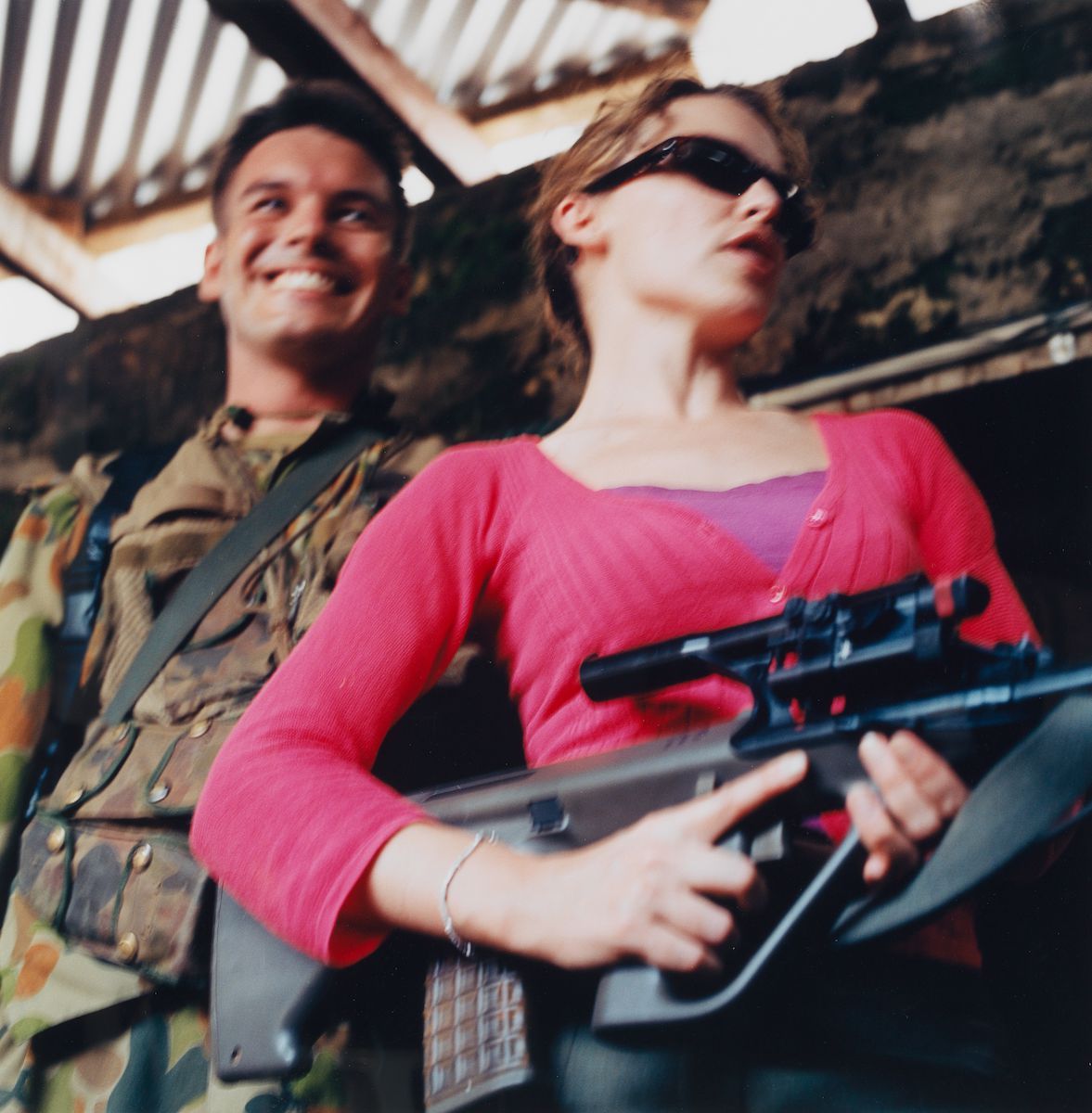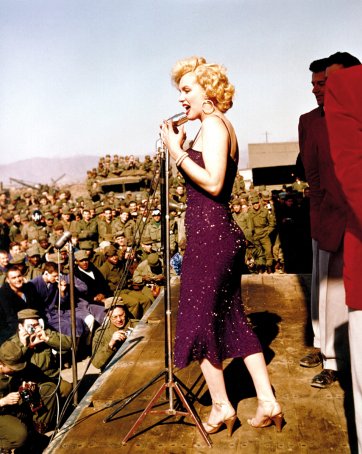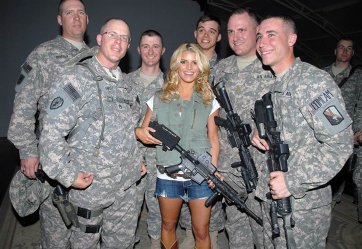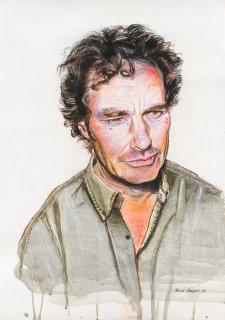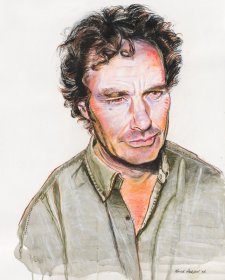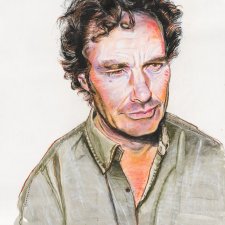Watching an American starlet leaving the stage after performing in front of
an audience of G.I.s, Bob Hope said ‘I just want you boys to see what you’re fighting for’. Since the 1940s the United Service Organizations has staged morale boosting camp shows and pictures of actors, comedians and musicians entertaining soldiers have become part the spectrum of images of war.
Soon after her marriage to Joe DiMaggio, Marilyn Monroe en route to Japan in February of 1954 took a four-day side trip to Korea and performed ten shows for 100,000 American soldiers. They were Marilyn’s first performances in front of an audience and she said that the reaction of the soldiers made her realise she had really made it as a star.
Roosevelt was the first and every US president since has been the Honorary Chairman of the USO. George Bush Senior said that ‘the USO is how America says thanks to those serving on the front lines of freedom and at home, it is a way to let them know we care and appreciate their service and sacrifice’. The rhetoric, however, does not acknowledge the origins of the organisation. Before America entered the Second World War it had begun drafting civilians and training them at bases in rural America. Under pressure to appease the locals who resented these on-leave strangers flooding into their hometowns, Roosevelt challenged six voluntary civilian agencies, the YMCA, YWCA, National Catholic Community Service, the National Jewish Welfare Board, the Traveler’s Aid Association and the Salvation Army to organise recreation for the servicemen. The USO’s formation was partly public relations and partly to get the soldiers out of bars and into church groups.
In the Iraq–Afghanistan era of unmanned drones, soldiers blogging their experiences and uploading videos to Youtube from their laptops, morale-boosting troop-thanking camp concerts are anachronistic. The link between celebrity and patriotism and the symbolism, whether it is the Dallas Cowboys Cheerleaders posing for souvenir photographs or Robin Williams on a stage in battle fatigues,
is as necessary, popular and potent as ever before.
In 1999 Australian artist Matthew Sleeth went to East Timor with an art project in mind. He had been living in Belfast creating art projects around the orthodoxies of war photography and, although he concedes that at the time he wasn’t really aware of the buildup or the politics of the situation, he headed for East Timor with the intention of creating an optimistic project on the theme of redemption.
In September of 1999 Australia led a multinational peacekeeping force to East Timor to restore security following the result of the UN sponsored independence referendum. When Sleeth arrived in East Timor he realised that his assumptions had been wrong and the project took a different direction. It was apparent to him that the United Nations, Australian government and the non-government organisations were less interested in the Timorese than they were in constructing the public image of the crisis and branding their efforts for audiences back home. The disparity between what the Timorese needed and the spin, Sleeth says was never more clearly evident than the USO-style Christmas concert ‘Tour of Duty: Concert for the Troops’ that featured John Farnham and Kylie Minogue.
Bob Hope and Anita Ekberg’s 1955 show at Thule Air Force Base in Greenland was the first televised USO performance. Jessica Simpson’s 2008 USO performance in Kuwait was also a live MySpace concert. Compared by Rampaging Roy Slaven and HG Nelson, ‘Tour of Duty: Concert for the Troops’ was telecast on two commercial networks in Australia as well as being webcast. Held at Dili Stadium in front of 4 000 troops, and despite the performances stopping for the ninety-second ad breaks, the concert was described as a special Christmas present to show appreciation and support for the troops stationed in East Timor, away from their families for Christmas.
On the world stage Timor was a small conflict and the details were never clear nor well understood. Sleeth created a critique of Australia’s response to the crisis in the form of eighty photographs that can be read as filmstills for a jingoistic movie: part Australia to the rescue and part unofficial advertisement. For the project called Tour of Duty Winning Hearts and Minds In East Timor and the accompanying monograph published in 2002, Sleeth took the stencil typeface from the title sequence of the 80s American TV show set during the Vietnam War ‘Tour of Duty’.
Australia’s inexperience in the leadership role for the InterFET gave Sleeth unhindered access to the people and the places including what he describes as the PR setpiece ‘Tour of Duty: Concert for the Troops’. Two photographs of Kylie Minogue from the Tour of Duty Winning Hearts and Minds In East Timor series have become part of the National Portrait Gallery collection, gifts of Patrick Corrigan AC. With the conventions of war photography in mind, in each of the photographs Sleeth intended to create shots that looked as though they were selling a product. Seductive and with the feel of lifestyle photography his technique combines a large format camera with square format colour negatives clearly distancing his work from the snapped at a moment reportage type of war photography .Sleeth, whose background is in film, talks a lot about editing his photographs for exhibition and publication as if they were a film. Tour of Duty Winning Hearts and Minds In East Timor was exhibited at the Centre for Contemporary Photography in Melbourne in mid-2002.
Sleeth’s photograph of Kylie posing with an Australian Army Styer rifle in a tough ‘Terminator’ stance with a beaming Australian Army Officer over her right shoulder appears to be part of the tradition of contrived images of performers ‘showing their support’ for their country’s military. For Sleeth the true narrative is an unexpected moment when the official story and the revealing subtext of the unofficial one intersect.
The soldier, who appears as if he’s ‘just happy to be there’ is Kylie’s old friend and co-star from the 1980s Australian TV show, ‘The Henderson Kids’. Kylie Minogue played the part of Charlotte ‘Char’ Kernow while Bradley Kilpatrick played Brian ‘Brains’ Buchanan. Captain Kilpatrick had deployed to East Timor as the Second in Command of B Squadron 3/4 Cavalry Regiment with InterFET in 1999. His mum had called Kylie’s mum to ask her if she’d go to East Timor as a favour to Brad. He stands behind Kylie relieved that the tense wait – the helicopter had been delayed by bad weather on its flight up to Balibo where the concert was staged – is over.
Matthew Sleeth’s project in East Timor ultimately comments not only on the repurposing of war stories for national audiences but Tour of Duty Winning Hearts and Minds In East Timor also instructs photojournalists, official war artists, freelancers, and us, the viewers, to see past the familiar imagery, clichés and contrivances derived from war to sell the role of a country in a conflict and to look more deeply into the lives of those directly affected.
